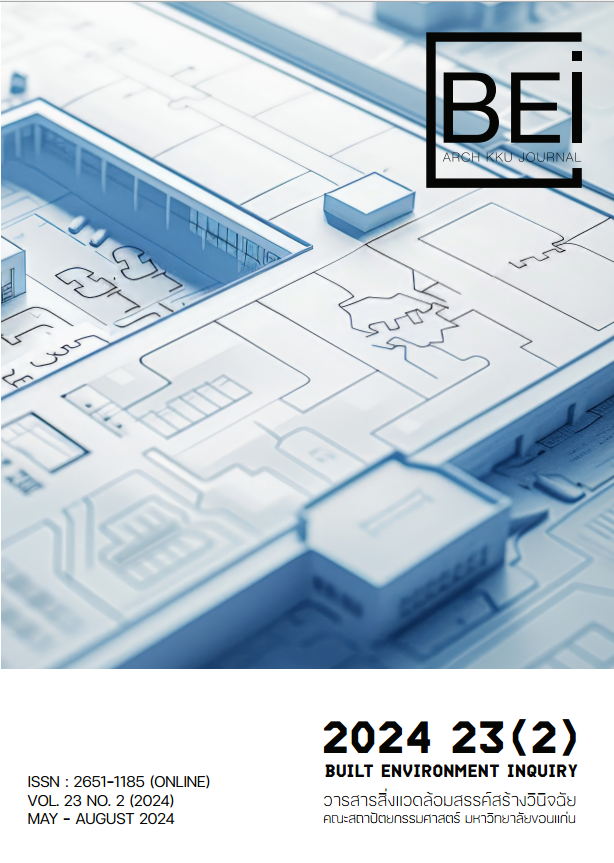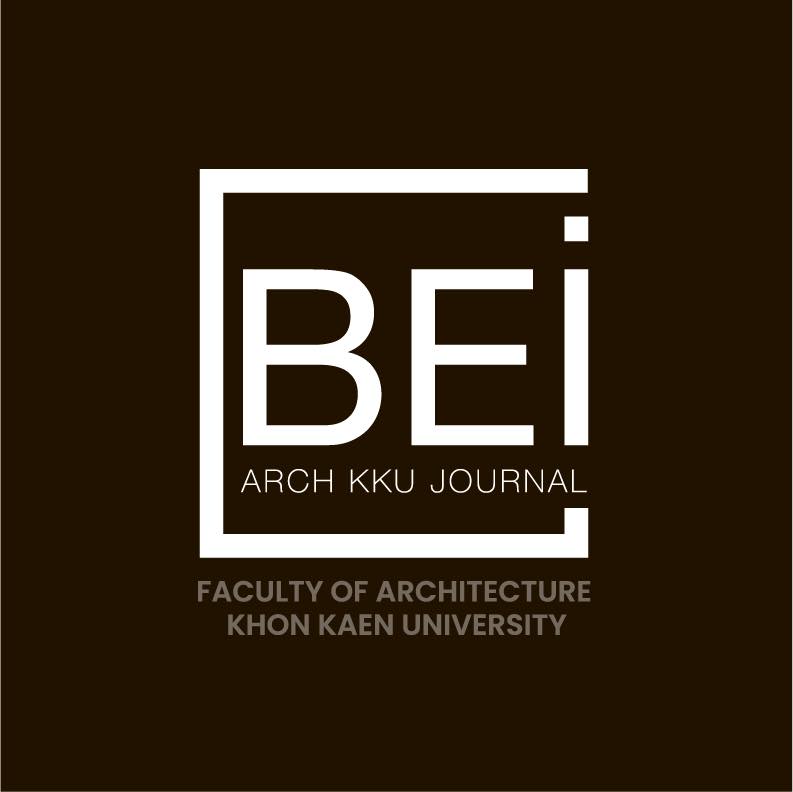Spatial Characteristics of Chiang Mai Old Town toward the Walkable City
DOI:
https://doi.org/10.14456/bei.2024.13Keywords:
Spatial Characteristics, Walking, Chiang Mai Old TownAbstract
This study aimed to analyze the characteristics of the Chiang Mai Old City area from the context and morphological structure of space, value of access to the area of the traveling network and related factors by using methods of document analysis, area survey, observation, and space syntax models.
The results of the study found that in the old city area of Chiang Mai, the inner-city wall area had an average width and length of grid road blocks of 243 meters and 340.50 meters, respectively. The outer city wall area of long road blocks along the road line had an average of width and length of 408.24 meters and 574.53 meters, respectively. Value of accessibility to areas of city-level mobility networks and the neighborhood level had a high value in the old city area. This related to the size of street blocks and commercial areas along main roads. The city and neighborhood level average access were 0.67756 and 1.31884, respectively. The outer city wall area had better street level accessibility at the 400 m and 800 m radii. Road sections that received a lot of traffic have averages of 671.479 and 4270.150, respectively, around the Suriyawong Road intersection, (Kad Kom Market) Nanthraram Road (Nantharam Temple) Wat Lai Road and Thippayanet Road (Thippayanet Market and Pratu Hai Ya Market)
However, it was found that the road sections with high access values for traffic to the destination area were connected between the inner city wall area and the outer city wall area at a radius of 800 meters, had an average of 96.1632 along Thippayanet Road, Wua Lai Road, Nantaram Road, Suriyawong Road, passing through Saen Prung Gate (Suan Prung) and Chiang Mai Gate to the inner city wall area along Kotchasan Road, Mun Mueang Road, Phra Pok Klao Road, Sam Lan Road, Tha Phae, Ratchadamnoen Road and Ratchamankha Road The said road connected the neighborhoods of the outer city wall area and the inner-city wall area at a walking distance of 800 meters, which is a consideration to promote appropriate travel in the old city area.
References
Al_Sayed, K. (2018). Space syntax methodology: A teaching guide for the MRes/MSc Space Syntax course (Version 5). Bartlett School of Architecture, UCL.
Apiradee Kasemsuk. (2018). Space syntax: The one of morphological study. Magic Publications Co. Ltd.
Cohen, N. (1999). Urban conservation. The MIT Press.
Couclelis, H. (2021). Conceptualizing the city of the information age. Springer.
Hillier, B. (1996). Space is the machine: A configurational theory of architecture. Cambridge University Press.
Hillier, B., & Hanson, J. (1984). The social logic of space. Cambridge University Press.
Lefebvre, H. (2000). A socialist in space. In M. Chrang & N. Thrift (Eds.), Thinking space (pp. 155-174). Routledge.
Massey, D. (2005). For space. Sage Publications Ltd.
Ministry of Tourism and Sports. (2023). Tourism statistic 2022. Retrieved from https://www.mots.go.th/news/category/655
Nes, A., & Yamu, C. (2021). Introduction to space syntax in urban studies. Springer.
Pranom Tansukanun, & Wittaya Daungthima. (2013). The multi-layered districts of Chiang Mai city. Pu-Pae Printing.
Pranom Tansukanun. (2022). A place of the soul: Chiangmai neighborhoods. Patra Prepress.
Pranom Tansukanun. (2022). จิตวิญญาณแห่งถิ่นที่: ย่านชุมชนของเมืองเชียงใหม่. ภทระ พรีเพรส.
Rattanakosin and Old City Conservation and Development Subcommittee. (2010). Notifications of the Chiang Mai old city. Retrieved from https://culturalenvi.onep.go.th/site/detail/355
Rieid, E. (1999). Pedestrian-and transit-friendly design: A primer for smart growth. American. Retrieved from https://19january2017snapshot.epa.gov/smartgrowth/pedestrian-and-transit-friendly-design_.html
Urban Design and Development Center. (2020). Chiang Mai walkable city. Retrieved from https://www.uddc.net/publications
กระทรวงการท่องเที่ยวและกีฬา. (2565). สถิติด้านการท่องเที่ยว ปี 2565. สืบค้นจาก https://www.mots.go.th/news/category/655
คณะอนุกรรมการอนุรักษ์และพัฒนากรุงรัตนโกสินทร์และเมืองเก่า. (2553). ประกาศเขตพื้นที่เมืองเก่าเชียงใหม่. สืบค้นจาก https://culturalenvi.onep.go.th/site/detail/355
ศูนย์ออกแบบและพัฒนาเมือง. (2563). เชียงใหม่ เมืองเดินได้. สืบค้นจาก https://www.uddc.net/publications
อภิรดี เกษมศุข. (2561). สเปซซินแท็กซ์ หนึ่งการศึกษาสัณฐานวิทยา. บริษัท เมจิค พับบลิเคชั่น จำกัด.
Downloads
Published
How to Cite
Issue
Section
License
Copyright (c) 2024 Built Environment Inquiry

This work is licensed under a Creative Commons Attribution-NonCommercial-NoDerivatives 4.0 International License.
Views and opinions expressed in the journal do not necessarily reflect those of the editors.



